For a sub-$200 camera, Samsung's 8-megapixel L830 packs some strange and useful features into its slimmer-than-it-feels frame. A manual exposure mode, manual color adjustments, and a high-resolution movie mode belie the camera's small price tag. However, features don't make the camera, and in the end we have to judge the L830 on how well it takes photos.
The Good
The Bad
The Bottom Line
Though it measures 0.9 inch at the widest part and weighs 5.4 ounces with battery and SD card, the L830 feels slightly thick compared with other slim, compact cameras. One reason for that might be the 2.5-inch LCD screen, which sits on a raised bezel. Still, the camera can easily slip into a pocket or slim case. The L830 uses a standard four-way-plus-OK joypad and four additional buttons for most of its controls. The buttons and zoom rocker feel a bit too small and flat to be entirely comfortable under large thumbs, but they're well placed and organized. Function and Effect buttons offer fast access to most settings, and a convenient face-detection button easily toggles the camera's face detection autofocus/auto-exposure mode on and off.
Despite its budget status, the L830 offers a manual exposure mode and color channel controls. The manual mode lets you adjust the shutter from 1/1,500 to 8 seconds and toggle the 38mm-to-114mm-equivalent lens between F/3.0 and F/7.7 at its widest position (or F/5.6 to F/14.1 at its farthest telephoto position). Unfortunately, it doesn't offer aperture or shutter priority modes; if you want to manually adjust exposure, it's all or nothing. In addition to a variety of color effects, the L830 lets you create your own color mode by adjusting individual red, green, and blue color channels. If you don't want to deal with the various controls, the L830 features a handful of scene preset modes on top of the standard automatic shooting mode. It can also shoot movies at near-SVGA (800x592) resolution, though only at 20 frames per second; if you want standard 30 fps video, you need to use the VGA (640 x 480) or lower-resolution modes.
Up to ISO 200, the camera took 2.8 seconds between shots with the flash disabled. At ISO 400 and above, that wait increased to 4.5 seconds. Most point-and-shoot cameras activate their noise reduction algorithms around ISO 400, so a slight increase in shot-to-shot time is understandable since the camera needs extra processing time. If you mostly shoot in automatic mode, you won't experience this issue; the automatic mode keeps sensitivity at ISO 200 or lower. If you like to shoot in high-speed and high-sensitivity modes, though, you can expect a much longer wait between shots.
In our other performance lab tests, the L830 showed mostly average results, though its time between shots with the flash enabled is longer than we'd like to see. It took 2.7 seconds from power-on to capturing its first shot. The shutter lagged 0.5 second with our high-contrast target and 1 second with our low-contrast target. At ISO 200 and lower, the camera took 3.7 seconds between photos with the onboard flash enabled. Finally, the L830 captured nine maximum-resolution shots in 7.8 seconds for a rate of 1.2 frames per second.
Despite the extra time the L830 takes trying to reduce noise at ISO 400 and above, it doesn't help much. Fine details, such as small text become blurry smears and heavy grain still washes over the pictures. Photos look much better at ISO 200 and below, though fine details still appear slightly soft. The L830's pictures generally look good enough for e-mailing and Web sites, but you should be careful when making prints; pictures shot at ISO 200 or below might look OK at sizes up to 8x10 inches, though ISO 400 or higher shots shouldn't be blown up beyond 4x6 inches. Besides noise and softened details, the L830 suffers from significant barrel distortion when shooting at the wide end of the lens. On the bright side, the camera reproduces colors well, and they stay intact up to ISO 800. At the camera's highest sensitivity of ISO 1,600, colors predictably become washed out, though at that level you won't see enough detail for that to really matter.
The Samsung L830 offers a strange mix of photographer-friendly controls, middling performance, and disappointing picture quality. Its slow shooting and poor pictures at higher sensitivity settings seriously hurt the camera's flexibility, but its generous set of manual exposure and color controls give you plenty of ways to tweak your low-ISO shots. Considering its scant price tag, the L830 offers a lot of camera for experienced, budget-minded photographers. If you ever need to shoot at ISO 400 or higher, though, look for another camera. The older Samsung S850 includes full manual exposure controls including aperture and shutter priority, and it offers slightly better performance and picture quality than the L830. If you're willing to go for a larger camera, Canon's PowerShot A570 IS is around the same price and has a 4x optical zoom lens as well as manual and aperture- and shutter-priority modes. Meanwhile, Sony's Cyber-shot DSC-W55, also in the same size and price range as the L830, trumps this camera in terms of shot-to-shot times and has an optical viewfinder.
(Shorter bars indicate better performance)
| Typical shot-to-shot time | Time to first shot | Shutter lag (typical) |
(Longer bars indicate better performance)

